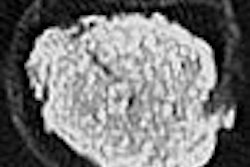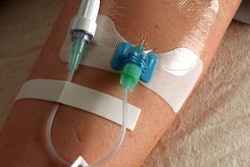The type of contrast medium used in percutaneous coronary interventions (PCIs) makes no statistically significant difference in outcomes among chronic renal disease patients in terms of nephrotoxicity.
"I was certainly surprised by these results. We thought that less of the agents would result in fewer problems for kidney patients. But that is not what happened," said Dr. Rainer Wessely, Ph.D., an associate professor of medicine at the German Heart Centre Munich.
Wessely and colleagues found no significant differences in the impact on patients whether iso-osmolar contrast medium (iodixanol 320) or low-osmolar contrast medium (iomeprol 350) was used with PCI.
Iodixanol is an iso-osmolar, dimeric, nonionic contrast agent that has been shown to reduce the risk of developing contrast-induced nephropathy in patients with elevated serum creatinine compared to low-osmolar contrast agents such as iomeprol. However, no protective effect has been shown in patients undergoing PCI, the authors explained.
In the Contrast Media and Nephrotoxicity Following Coronary Revascularization by Angioplasty (CONTRAST) trial, researchers hoped to find a strategy that could lessen the threat of nephrotoxicity among renal disease patients undergoing PCIs that require contrast agents known to cause kidney problems.
"Patients with chronic renal failure are at increased risk for contrast medium-induced nephropathy that is associated with adverse outcomes," Wessely said at the 2008 American College of Cardiology (ACC) meeting in Chicago.
"Patients with chronic renal insufficiency have a high need of coronary procedures; however, these procedures involve the use of contrast medium, which may lead to contrast-induced nephropathy or further kidney damage," he explained.
Adult patients with chronic renal failure were eligible for the trial if they were scheduled for coronary angiography with the intention of going on to have angioplasty. Chronic renal failure was defined as a glomerular filtration rate of 60 mL/min or less, or a serum creatinine of 1.5 mg/dL or more. The study's primary end point was a rise in serum creatinine during hospitalization for the PCI.
The researchers enrolled 975 patients into the study, assigning 477 to receive iso-osmolar contrast medium and randomizing 498 patients to receive low-osmolar contrast medium. The analysis included the 162 patients in each group that actually had angioplasty performed. Approximately 38% of the patients had diabetes, and 78% had complex (B2/C) lesions at angiography.
The patients who received iso-osmolar contrast entered the study with an average serum creatinine of 1.36 mg/mL; following hospitalization, they had serum creatinine of 1.55 mg/mL, an increase of 0.19 mg/mL. The patients receiving low-osmolar contrast medium entered the study with average serum creatinine of 1.37 mg/mL; after the intervention, they had serum creatinine of 1.59 mg/mL, an increase of 0.22 mg/mL (p = 0.51).
Rates of severe contrast-induced nephrotoxicity were not significantly different between the two agents, occurring in 6.2% of patients in the iso-osmolar group and 3.7% of those receiving low-osmolar contrast medium (p = 0.30). The need for dialysis was low in both groups, with 1.9% of patients receiving iso-osmolar contrast medium requiring dialysis and 0.6% of low-osmolar patients needing dialysis (p = 0.31). Patients remained in the hospital an average of 6.3 days if they received iso-osmolar contrast medium and 6.5 days if they received low-osmolar contrast medium (p = 0.59).
Contrast-induced nephropathy occurred in 22.2% of patients on iso-osmolar contrast medium and 27.7% of patients on low-osmolar contrast medium (p = 0.25).
The outcomes were similar in both groups: About 2.5% of each group required target vessel revascularization (p = 1.00); about 3.7% of patients getting iso-osmolar contrast medium experienced myocardial infarction, compared with 4.3% of patients receiving low-osmolar contrast medium (p = 0.77). No stent thrombosis occurred in either group.
About 1.2% of the iso-osmolar patients died, compared with 1.8% of the low-osmolar patients (p = 0.65). Major adverse coronary events occurred in 6.2% of iso-osmolar patients, compared with 6.8% of low-osmolar patients (p = 0.85).
The results showed that the iso-osmolar and low-osmolar contrast agents have similar nephrotoxicity. The fact that all patients received intravenous hydration before and after the intervention may have reduced the overall incidence of contrast-induced nephropathy, and emphasizes the importance of this routine measure in renal patients undergoing PCI, Wessely and colleagues concluded.
By Edward Susman
AuntMinnie.com contributing writer
April 17, 2008
Related Reading
Automated patient-based contrast application cuts CTA contrast volume, risk, March 7, 2008
GFR no better than creatinine for predicting renal failure, December 18, 2007
Sodium bicarbonate best for prevention of contrast-induced nephropathy, October 29, 2007
MR experts take issue with FDA gadolinium warning, September 18, 2007
Trial shows promise for preventing radiocontrast nephropathy, December 7, 2006
Elderly need less contrast for pancreatobiliary imaging, August 2, 2006
Copyright © 2008 AuntMinnie.com



















